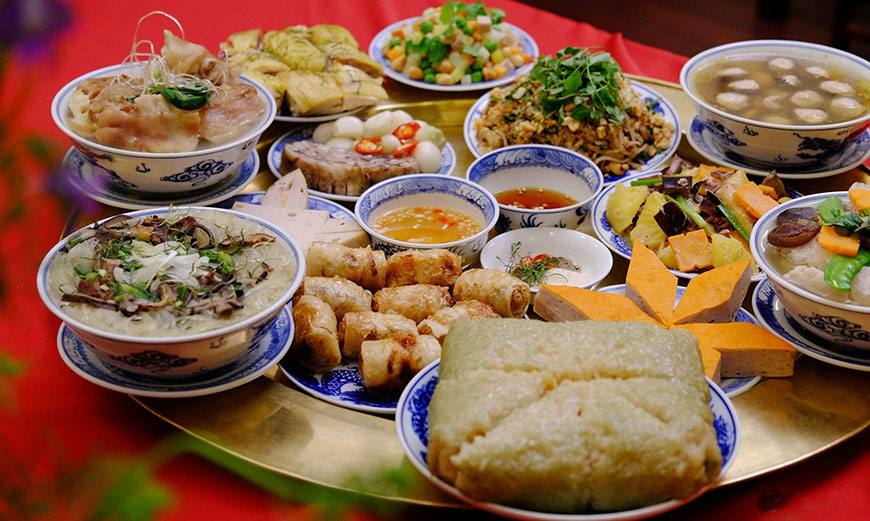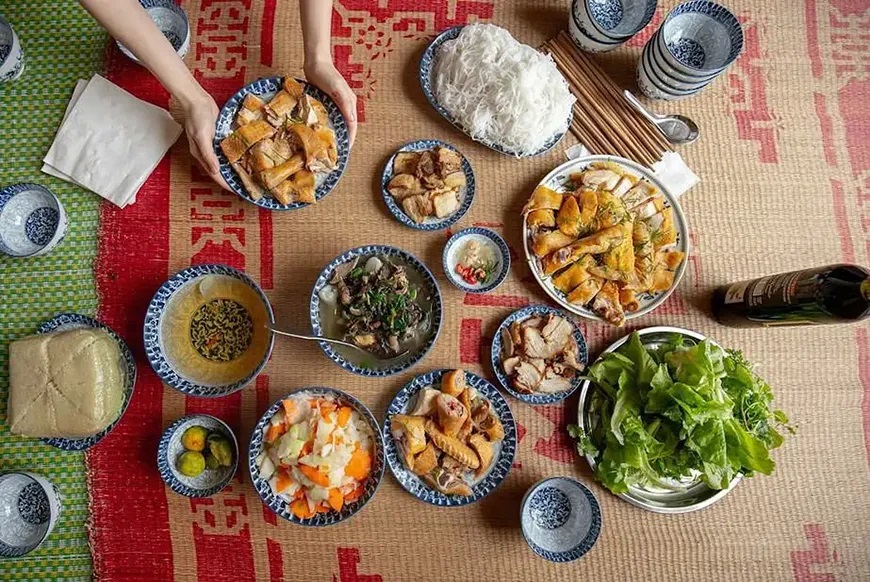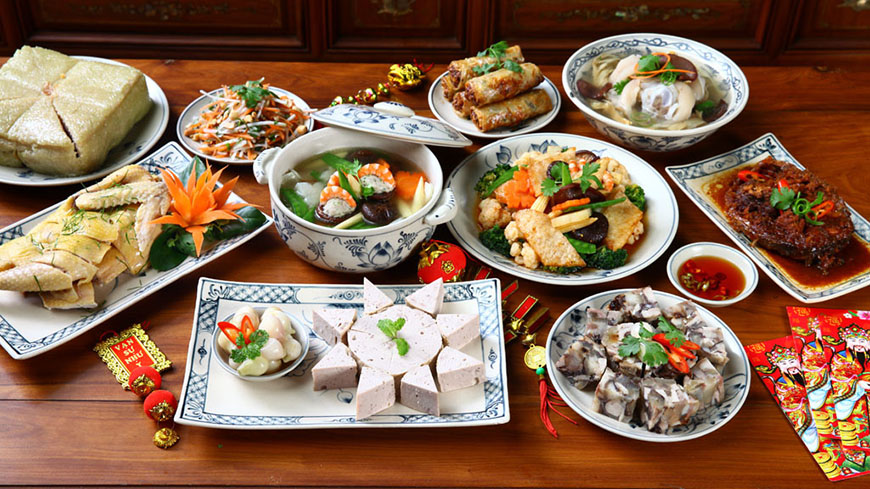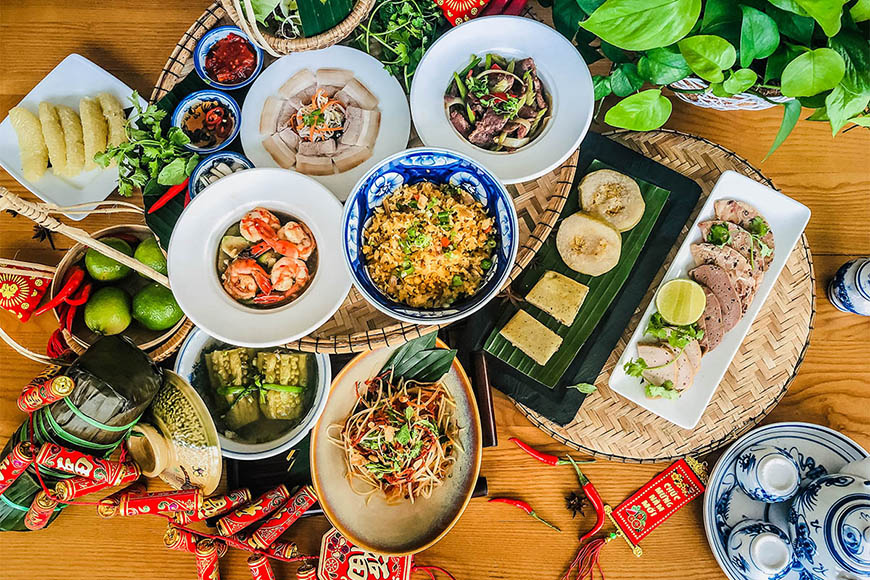Introduction
Tet Nguyen Dan is also known as Tet Ca (Big Tet), Tet Ta (Vietnamese New Year), Tet Am Lich (Lunar New Year), Tet Co Truyen (Traditional New Year), or simply known as Tet. It is the most important holiday in Vietnam, according to the cultural influence of the Chinese Lunar New Year and The Eastearn Asian cultural sphere.
In the culinary culture of the land of the blue dragon, the meal of the Tet must be meticulously and beautifully prepared. A great feast must include either 6 bowls and 6 plates, or 8 bowls and 8 plates, symbolizing prosperity and fortune. Throughout the centuries, the celebration of the Lunar New Year still preserves the traditional nature of the Vietnamese people.

Special Dishes for Tet - Photo : internet
A tradition lost in the mists of time
Traditionally, Lunar New Year meals are usually composed of special dishes, different from everyday meals. Over time, the Tet meal has also undergone many changes. However, if the dishes have diversified, one thing remains unchanged: the meal of the Vietnamese Tet is still abundant, with many delicious and colorful dishes, such as the green color of Banh Chung, the vibrant red of the glutinous rice Gac, the yellow of the bamboo sprouts soup, and the pink of the Vietnamese mortadella and the colorful Nem....
Traditional dishes of the Lunar New Year
The most common traditional Tet dishes are:
This is a sticky rice cake stuffed with pork, mung beans and pepper. It is usually served with bamboo shoot soup.
Similar to banh chung, it is rolled in the shape of a cylinder. It is usually served with nuoc mam, a fermented fish sauce.
If you ask someone in Vietnam what food comes to mind first when talking about Tet, you can be sure that the answer is banh chung or banh tet, as they say in the South. As the whole family, or almost, gathers around the fire to cook banh chung or banh tet, stories circulate about past Tet celebrations, and the difficulties of the past year slowly melt into the warmth and shared happiness. Although these two types of rice cake are essentially composed of glutinous rice, fatty pork and mung beans carefully wrapped in banana or phrynium leaves, there is a notable difference between them. In both cases, the sticky rice should be of very good quality and soaked in water the day before. Then it will be wrapped in a square or cylindrical shape, neither too tight nor too loose, and finally boiled for about 12 hours on a wood fire. This rice cake with delicious flavor can be kept for a long time.
Who does not know the famous Vietnamese spring rolls, made of rice leaf, meat, vegetables and vermicelli! They are usually served with a sauce based on nuoc mam, lime and sugar.

Traditionnal Tet Dinner - Photo : internet
This dish is prepared with sticky rice that is dyed red with fruits of the jackfruit. In ancient beliefs, red is the color of luck and marital happiness. Therefore, on full moon days, holidays and especially during the Tet, you have to eat a plate of sticky rice Gac. Gac sticky rice is steamed. After being cooked, the sticky rice will have a beautiful and attractive bright red color. When you eat it, you will feel the sticky texture of sticky rice, the fatty taste of coconut milk and the sweetness of sugar.
This term refers to a soup with dried bamboo shoots.
It is not uncommon to find during Tet this pork dish simmered in a sweet and salty sauce.
Boiled chicken plays an important role in Tet’s cooking because all ancestral tribute meals must contain it. It is also another popular food during Tet and is easy to make: the chicken is simply boiled then it is accompanied by lemon leaves and chili salt, to create an unforgettable taste. Care will be taken to eat it only after it has been presented on the altar of the ancestors.
-
Vietnamese sausage (Gio Cha)
Gio Cha is another common element of the traditional Tet menu. There are three types of this sausage, namely Gio lua (sausage made from ground pork, fish sauce and black pepper), Gio bo (made from pulled beef) and Gio thu (made from pork, ear, nose, tongue). Similar to banh chung and banh tet, gio cha is tightly packed in green leaves. The mixture of ingredients is boiled or carefully steamed. The roll is cut into pieces and served cold.
Jam Tet is an indispensable treat during the Lunar New Year Festival. More than a traditional Tet food, Mut Tet, arranged in beautiful boxes placed on the living room table, welcomes guests and serves as an offering to the ancestors. Mut Tet is available in coconut, carrot, lotus seed, ginger or kumquat.
In addition to these traditional dishes, the Vietnamese also prepare fruits, vegetables and special desserts for Tet. The most popular fruits are tangerines, apples, oranges and bananas. The most popular vegetables are carrots, onions, peppers and bamboo shoots. The most popular desserts are pastries, sweets and ice cream.

Special Cuisine for Tet - Photo : internet
The cuisine of Tet according to the regions
Dishes from North Vietnam
As seen above, the typical dishes of Tet are – among others and for the North of Vietnam – red sticky rice (colored with Gac), pickled onions, fried nems, boiled chicken or pork skin meatball soup.
Central Vietnam Dishes
The people of the Centre like to share Banh Tet, Nem chua (fermented pork), or marinated meat with fish sauce during the holiday season.
Dishes from South Vietnam
The South rather feasts with braised meat, stuffed bitter cucumber, dried shrimp or this very particular sausage that should be found all year round so good. We will not forget to honour Canh khi qua nhoi thit, a stuffed squash soup considered a symbol of wealth and fortune. At least we prefer Tom rang bo, a dish of fried shrimp with butter, also considered a symbol of prosperity and luck.

Lunar New Year Dishes - Photo : internet
Conclusion
Exceptional time, exceptional cuisine! The Lunar New Year Tet cuisine in Vietnam is rich and varied, with traditional dishes that symbolize prosperity, luck and good health. The typical cuisine of Tet Nguyen Dan is an opportunity to meet with family and share moments of joy.